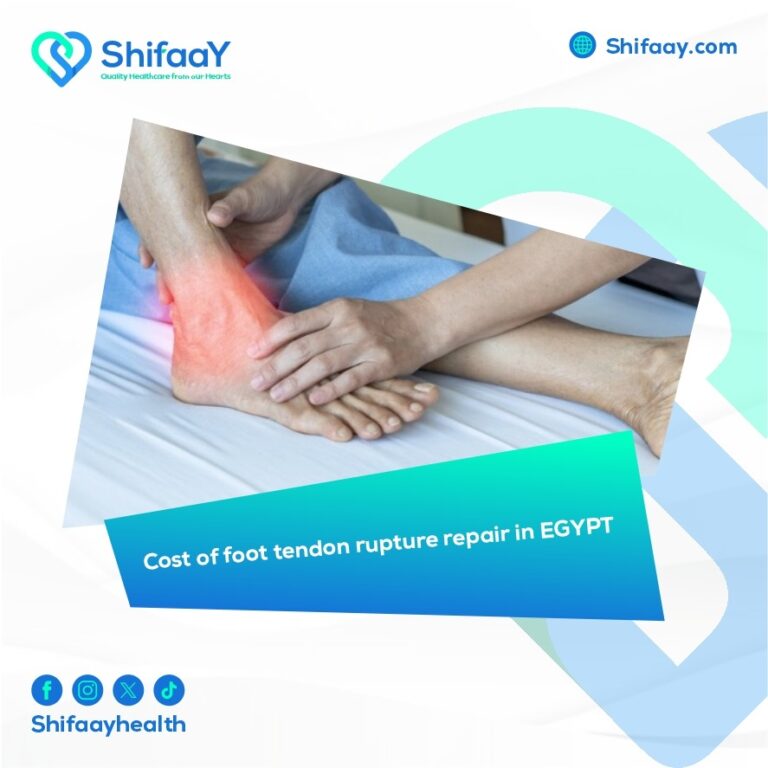Hallux valgus surgery in Egypt
This article will focus on hallux valgus surgery, also known as “bunion,” a condition where many people experience the appearance of a bony deformity in the foot, specifically at the base of the thumb toe in the metatarsophalangeal joint. This deformity can cause the hallux to curve inward towards the second toe, causing the first metatarsal bone to protrude. Bunion is a serious problem that causes the foot to appear unattractive and is accompanied by intense and excruciating pain and inflammation. The best way to treat this condition is to seek out the most appropriate and effective treatment options under the guidance of an orthopedic expert in Egypt.
It is important to note that there are a number of factors that could increase the risk of developing hallux valgus. Genetics is the most prominent factor among these factors because it has the potential to significantly affect the shape and form of the foot. It is considered one of the most important causes of hallux valgus in many individuals. Moreover, flat feet or laxity of the foot’s tendons and joints may also be important factors in the rising incidence of hallux valgus. It should be noted that wearing tight or high-heeled shoes can worsen the hallux valgus condition, which explains why so many women develop this problem while men do not.
This is the reason why some people might start looking for effective therapeutic methods that will enable them to get rid of hallux valgus, get rid of all the pain that goes along with it, and get their mobility back. Therefore, we are happy to introduce to you the most skilled and experienced orthopedic surgeon at the Shifaay Center, who stands out for having extensive experience in this field.
To address this issue, we typically perform a hallux valgus surgery, which is thought to be the best and ideal way to reduce swelling at the thumb joint and relieve all pain and inflammation. Of course, this procedure is used only after all non-surgical therapeutic measures have failed to reduce the swelling.
Hallux valgus surgery

Hallux valgus surgery, also known as “bunion,” is a surgical procedure intended to treat all bone deformities arising in the hallux valgus. This condition may cause the thumb to deviate toward the other toes and may appear as bony protrusions involving both soft tissue and bone on the inner side of the foot.
Surgery is the final option for treating conditions for which non-surgical methods are not successful in treating the bunion. The aim is, of course, to return the foot to its pain-free normal function, but even with this understanding, it is important to keep in mind that the surgical procedure may not result in the foot looking exactly as it should.
Follow also: Total ankle joint replacement surgery
Bunion Surgery
Hallux valgus, also called a bent toe, tilted toe, or bunion, is a bony deformity that is very common among many women. It is caused by the big toe’s curvature and clear deviation from the outer edge of the foot, which causes the smaller toes on the other side to move. This major deformity may be very attractive to many women, but it may also be disturbing to many others, especially if it makes it difficult for them to wear their favorite shoes. As the condition progresses, the strain on the metatarsal joint may worsen the deformity. This can eventually result in painful bony bumps, cystic infections, and swellings, as well as hammer or claw toes on the other touching toes. It can also make it harder to wear shoes. Finally, the prominent person may be more vulnerable to infections, which often cause excruciating swellings.
This major deformity is usually corrected by some gentle and minimally invasive surgical operations, which often do not leave visible scars on the foot, performed by the skilled doctors and specialists at the Shifaay Center who specialize in treating minor hallux deformity. This helps to improve the process of accelerating recovery and rehabilitation again, as well as avoiding any complications and risks that may arise after hallux valgus surgery. It is therefore necessary to visit Shifaay Center for a thorough examination and treatment of this issue as soon as possible in order to regain the ability to move and enjoy the medical and cosmetic improvement of hallux valgus. If the bone deformity is worse, the surgical procedure will be more difficult and complicated and the patient will not recover quickly.
What are the indications for hallux valgus surgery?
There are a number of clear important reasons for performing hallux valgus surgery, the most prominent of which are as follows:
● Severe, unbearable foot pain that may limit ability to perform daily tasks and activities like walking.
● Swelling of the big toe, which could be a significant hindrance to donning suitable footwear.
● Chronic big toe swelling and inflammation that does not go away even after getting enough sleep and taking medicine.
● The hallux is not flexed or extended by the foot.
● Stiff toes.
● inability to relieve the pain brought on by a swollen bunion, despite using medical shoes and painkillers.
● The apparent deformity of the toes, which causes the remaining toes to crowd together and rise above one another.
The decision to have a bunion surgery is one of the most important ones, and it always requires careful consideration of the benefits and complications, as well as listening to the advice of doctors and specialists who are experts in this field and affiliated with Shifaay Center the best medical tourism center in Egypt, which is regarded as the best tourism center in Egypt. This is even though most people may not want to perform such an operation, in cases where the swelling may significantly and seriously affect the patient’s ability to perform daily tasks and activities, in which it may be difficult for any non-surgical treatment methods to succeed.
Preparing for Hallux Valgus Surgery
There are a number of important and necessary medical examinations that must be performed in order to ensure the patient’s ability to withstand the surgery for hallux valgus, or “bunion,” prior to performing the procedure. Some of the most noteworthy examinations that must be performed are as follows:
● Laboratory tests such as urine and blood tests.
● Electrocardiogram (ECG).
● Chest X-ray to confirm lung function.
● X-ray imaging of the foot.
The following preliminary measures need to be taken prior to having the procedure to remove the hallux valgus:
● providing your doctor with a comprehensive list of all the prescriptions you take for your medical condition will enable them to prevent you from taking specific types of medication before the procedure. Examples of these medications include anticoagulants and others.
● It is necessary to give up smoking for at least a full month prior to the procedure in order to improve the chances that the wound will heal quickly.
Hallux Valgus Surgery Procedure Guide
Prior to any hallux valgus surgery, the appropriate type of anesthetic must be selected, based on whether the condition calls for spinal, local, or general anesthesia. The phases that follow anesthesia might vary depending on the kind of surgery the patient will have, which is obviously dependent on the state of the hallux valgus. It has, which may be divided into:
● Bunionectomy Procedure
● Osteotomy Procedure
● Fusion Procedure
The procedure for bunion surgery is as follows:
- First, the skilled doctor affiliated with the Shifaay Center administers a general, semi-annual, or local anesthetic to the patient.
- The doctor then makes a skin incision to gain access to the big toe bones and joint.
- After that, the orthopedic doctor removes the enlarged tissue close to the hallux joint, along with the swelling and bone spur.
- The thumb is then realigned to its natural position, placing it in the proper location, after he realigns and rearranges the bones of the foot and finger to eliminate the angle it had taken.
- Next, the doctor lengthens or shortens the metatarsals, depending on whether it is necessary because of a medical condition.
- The doctor will then use screws and plates to fix the joint if there is a significant amount of roughness in the big toe.
Hallux osteotomy
The osteotomy procedure for removing hallux swelling entails removing the protruding part of the bone’s so-called head in order to align it with the metatarsophalangeal joint, and then fixing the bone at the site of the abrasion to the bone with special plates and screws until the bone heals.
hallux fusion surgery
Thumb arthrodesis may entail scraping the surface of the injured joint and then securing the bones to the bone with special plates and screws until the injury heals in pathological cases of extremely severe swelling of the foot pyramid. Remarkably, this treatment is often performed on patients who have severe arthritis.
Complications and risks of bunion removal surgery

It is common knowledge that after a hallux valgus surgery, risks and complications can arise that are similar to those that arise from any surgical procedure, potentially requiring further procedures.
Several possible risks and complications may arise during the bunion removal surgery, such as:
● Some infections around the surgical wound.
● Continued severe pain.
● Bunion returns again.
● Nerve damage to the affected area.
● Swelling of the joint in the thumb.
● Very slow healing of the surgical incision.
● Stiffness of the hallux joint.
Also follow: Callus removal surgery (Corn removal surgery)
What is the process of repairing a misaligned big toe?
The procedure known as ” hallux valgus surgery” which corrects the big toe deviation, is a surgical procedure used to address the deviation that originates in the foot’s thumb. Usually, the goals of this procedure are to realign the big toe, lessen pain and inflammation there, fix any deformities the patient may have had, and allow them to wear shoes normally again.
How is big toe deviation surgery performed?
The procedure for treating hallux valgus “bunion” involves several crucial steps. First, the patient may be given local anesthesia to help with the condition. Next, the doctor may perform a minor skin incision to gain access to the hallux joint and bones. Once the deformity is corrected, additional procedures such as joint restoration, decompression, removal of the deformed portion, realigning the bones, and moving the bones to their proper position may be carried out.






